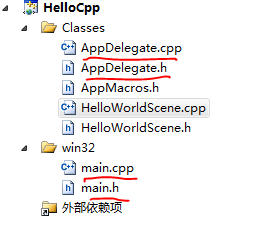cocos2d-x 下的HelloWorld
参考了沈大海的博客:
为什么要定义windows平台
因为在不同平台有不同的程序入口实现方式,如windos平台有main.h和main.cpp,android平台有入口的Activity,iso平台有main.m,
但对于各平台的入口差异在cocos2d-x中做了完美的一致化处理,暂且不管是如何进行的,我们只需要基于一致的引擎入口进行开发就好了,
对于cocos2d-x引擎的入口我们定义为AppDelegate.h和AppDelegate.cpp看这里面的方法有三个。
如下图:windows下工程的入口和引擎入口:

这几个方法会在各平台应用程序状态改变时候自动回调。
而状态的改变在不同平台是有差异的,cocos2d-x定义cocos2d::CCApplication类统一了各平台的差异,在cocos2d-x中只有1个窗口在运行(符合移动平台,但pc平台原本不是这样),窗口在分配空间,加载完成,被覆盖,被恢复时候会自动回调CCApplication中的函数,因此CCApplication在不同的平台,有不同的实现cpp,
(有兴趣同学可以阅读cocos2ds/platform下面的源代码,从cocos2d::CCApplication.h开始)
看注释就已经很明白了:
和android的每个activity的活动周期差不多
1 2 3 4 5 6 7 8 9 10 11 12 13 14 15 16 17 18 19 20 21 22 23 24 25 26 27 28 29 30 31 32 33 34 35 36 37 | #ifndef _APP_DELEGATE_H_#define _APP_DELEGATE_H_#include "cocos2d.h"/**@brief The cocos2d Application.The reason for implement as private inheritance is to hide some interface call by CCDirector.*/class AppDelegate : private cocos2d::CCApplication{public: AppDelegate(); virtual ~AppDelegate(); /** @brief Implement CCDirector and CCScene init code here. @return true Initialize success, app continue. @return false Initialize failed, app terminate. */ virtual bool applicationDidFinishLaunching(); /** @brief The function be called when the application enter background @param the pointer of the application */ virtual void applicationDidEnterBackground(); /** @brief The function be called when the application enter foreground @param the pointer of the application */ virtual void applicationWillEnterForeground();};#endif // _APP_DELEGATE_H_ |
----------------------------------------------------------------------------------------------------------------------------------
在这几个方法中,就可以做我们要做的事情了。
applicationDidFinishLaunching启动完成
加载游戏,播放音乐
applicationDidEnterBackground进入背景
音乐暂停,游戏暂停
applicationWillEnterForeground恢复窗口
音乐继续,游戏继续
可能,你会想,如果应用退出,我想保留游戏数据如何?
试者找找ccApplication中还有哪些方法。
1 2 3 4 5 6 7 8 9 10 11 12 13 14 15 16 17 18 19 20 21 22 23 24 25 26 27 28 29 30 31 32 33 34 35 36 37 38 39 40 41 42 43 44 45 46 47 48 49 50 51 52 53 54 55 56 57 58 59 60 61 62 63 64 65 | bool AppDelegate::applicationDidFinishLaunching() { // initialize director 初始化导演,他是引擎的老大,单例模式 CCDirector* pDirector = CCDirector::sharedDirector(); CCEGLView* pEGLView = CCEGLView::sharedOpenGLView(); //绑定opengles窗口,可见,我们可以自定义openGLView pDirector->setOpenGLView(pEGLView); CCSize frameSize = pEGLView->getFrameSize(); // Set the design resolution#if (CC_TARGET_PLATFORM == CC_PLATFORM_WINRT) || (CC_TARGET_PLATFORM == CC_PLATFORM_WP8) pEGLView->setDesignResolutionSize(designResolutionSize.width, designResolutionSize.height, kResolutionShowAll);#else pEGLView->setDesignResolutionSize(designResolutionSize.width, designResolutionSize.height, kResolutionNoBorder);#endif vector<string> searchPath; // In this demo, we select resource according to the frame's height. // If the resource size is different from design resolution size, you need to set contentScaleFactor. // We use the ratio of resource's height to the height of design resolution, // this can make sure that the resource's height could fit for the height of design resolution. // if the frame's height is larger than the height of medium resource size, select large resource. if (frameSize.height > mediumResource.size.height) { searchPath.push_back(largeResource.directory); pDirector->setContentScaleFactor(MIN(largeResource.size.height/designResolutionSize.height, largeResource.size.width/designResolutionSize.width)); } // if the frame's height is larger than the height of small resource size, select medium resource. else if (frameSize.height > smallResource.size.height) { searchPath.push_back(mediumResource.directory); pDirector->setContentScaleFactor(MIN(mediumResource.size.height/designResolutionSize.height, mediumResource.size.width/designResolutionSize.width)); } // if the frame's height is smaller than the height of medium resource size, select small resource. else { searchPath.push_back(smallResource.directory); pDirector->setContentScaleFactor(MIN(smallResource.size.height/designResolutionSize.height, smallResource.size.width/designResolutionSize.width)); } // set searching path CCFileUtils::sharedFileUtils()->setSearchPaths(searchPath); // turn on display FPS pDirector->setDisplayStats(true); // set FPS. the default value is 1.0/60 if you don't call this //设置FPS 在cocos2d-x 启动后内部封装了FPS的逻辑,虽然helloWorld图片没变化,但其实一直在重绘。 pDirector->setAnimationInterval(1.0 / 60); // create a scene. it's an autorelease object 创建一个场景 CCScene *pScene = HelloWorld::scene(); // run 显示这个场景到窗口,必然所有的绘制在场景中定义的 pDirector->runWithScene(pScene); return true;} |
1 2 3 4 5 6 7 8 9 10 11 12 | void HelloWorld::menuCloseCallback(CCObject* pSender){ CCLog("click the menu");#if (CC_TARGET_PLATFORM == CC_PLATFORM_WINRT) || (CC_TARGET_PLATFORM == CC_PLATFORM_WP8) CCMessageBox("You pressed the close button. Windows Store Apps do not implement a close button.","Alert");#else CCDirector::sharedDirector()->end();#if (CC_TARGET_PLATFORM == CC_PLATFORM_IOS) exit(0);#endif#endif} |
总结:
1 Director启动一个scene。
2 addChild
3 回调函数
4 CCLog




【推荐】编程新体验,更懂你的AI,立即体验豆包MarsCode编程助手
【推荐】凌霞软件回馈社区,博客园 & 1Panel & Halo 联合会员上线
【推荐】抖音旗下AI助手豆包,你的智能百科全书,全免费不限次数
【推荐】博客园社区专享云产品让利特惠,阿里云新客6.5折上折
【推荐】轻量又高性能的 SSH 工具 IShell:AI 加持,快人一步
· DeepSeek 解答了困扰我五年的技术问题
· 为什么说在企业级应用开发中,后端往往是效率杀手?
· 用 C# 插值字符串处理器写一个 sscanf
· Java 中堆内存和栈内存上的数据分布和特点
· 开发中对象命名的一点思考
· 为什么说在企业级应用开发中,后端往往是效率杀手?
· DeepSeek 解答了困扰我五年的技术问题。时代确实变了!
· 本地部署DeepSeek后,没有好看的交互界面怎么行!
· 趁着过年的时候手搓了一个低代码框架
· 推荐一个DeepSeek 大模型的免费 API 项目!兼容OpenAI接口!